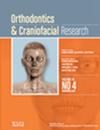Polish Version of the Malocclusion Impact Questionnaire (MIQ): Translation, Cross-Cultural Adaptation and Validation
Abstract
Aim
To translate the malocclusion impact questionnaire (MIQ) into Polish, adapt it for Polish cultural conditions, and validate its usage.
Subjects and Methods
The original MIQ was translated into Polish following a seven-stage cross-cultural adaptation protocol. A total of 121 orthodontic patients participated in the study: 21 in the translation and cultural adaptation phase (5 males, 13.4 ± 1.5 years; 16 females, 13.6 ± 1.9 years) and 100 in the validation phase (53 males, 13.1 ± 1.6 years; 47 females, 12.9 ± 1.7 years). Confirmatory factor analysis (CFA) was conducted to confirm the one-dimensional structure of the MIQ_PL. Reliability was assessed using Cronbach's alpha for internal consistency and intraclass correlation coefficients (ICCs) for test–retest reliability, whereas construct validity was evaluated by comparing MIQ_PL scores with responses to global questions 1 and 2 from the MIQ_PL questionnaire and the aesthetic component of the index of orthodontic treatment need (IOTN-AC).
Results
The MIQ_PL was generally well understood by the test group and required only minor adjustments, indicating it is well adapted to the Polish cultural context. The internal consistency, measured by Cronbach's alpha, was 0.68, and the intraclass correlation coefficient for test–retest reliability was 0.75, indicating adequate reliability. Many questionnaire items had a high floor effect. The correlation coefficients between global questions 1 and 2 and the MIQ_PL scores were 0.269 and 0.407, respectively, whereas the correlation between the IOTN-AC and MIQ_PL was 0.235.
Conclusions
The MIQ_PL is culturally adapted for Polish conditions but demonstrates lower than expected reliability and internal consistency. Further validation in non-clinical settings with a more diverse sample is recommended.

 求助内容:
求助内容: 应助结果提醒方式:
应助结果提醒方式:


